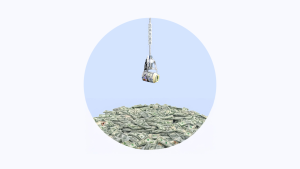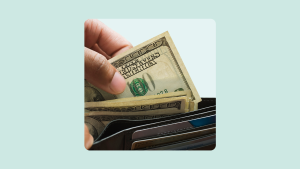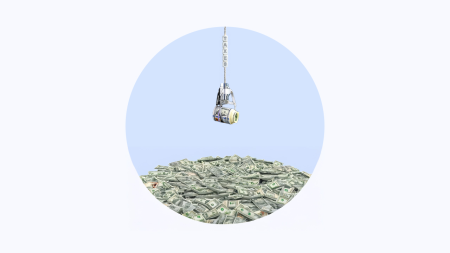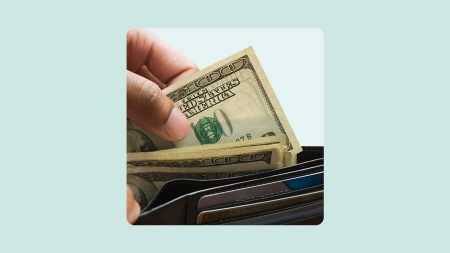Savers, take note: Your options for high-yielding certificates of deposit (CDs) are getting fewer by the day. What’s more, high-yield savings and money market accounts – variable rate deposit accounts that are prone to change in lock step with changes to the federal funds rate as set by the Federal Reserve – could see their yields drop before the Fed’s next interest rate meeting on Sept. 18.
Financial pundits and market prognosticators are confident that the Fed will lower interest rates in September. As of Aug. 8, the CME Group FedWatch tool, which is based on federal fund futures contract prices, projects a 100 percent likelihood of a rate cut. Inflation is down and unemployment is up, two reasons for the Fed to lower rates at its next meeting.
But the latest performance in financial markets has also affected some yields on deposit accounts, most notably CDs. In the course of a few days late last week, economic uncertainty in the U.S. over inflation, a weakening jobs report and fears of a possible, yet unsubstantiated, recession, sent financial markets roiling, particularly in Japan.
Here’s what you need to know about how global financial markets and economic indicators can affect yields on deposit accounts such as CDs and high-yield savings, and how you should prepare for other future roadblocks in a declining rate environment.
What has happened in the financial markets as of late?
The dog days of summer have hardly been lazy for both the U.S. and global economies as markets were reacting wildly to economic rumors and predictions. Although the Fed decided once again not to lower rates at its July 31 meeting, Fed chair Jerome Powell said rate cuts could be on the table in September, causing some banks to begin lowering annual percentage yields (APYs) on their CDs.
Then there was the disappointing U.S. jobs report on Aug. 2, followed by the unwinding of the Japanese “Yen carry trade” – where institutional investors borrowed against the yen at near-zero rates to buy growth stocks – causing Japan’s Nikkei index to plunge 12.4 percent on Aug. 5, it’s worst drop since 1987. Later that day, in the U.S., the Dow Jones Industrial Index fell 2.6 percent, a drop of more than one thousand points, further prompting speculation that the Fed may cut rates sooner.
It’s been a little more than a year since the Fed last increased the fed funds rate for the 11th time in the current rate cycle, which remains at a range of 5.25-5.50 percent. After being in an increasing and elevated rate environment since March 2022 – and with inflation currently more or less under control – what goes up has to come down. And that’s why the Fed is likely to lower the federal funds rate to help maximize employment and stabilize prices.
What recent trends in the markets mean for deposit accounts
Recent economic uncertainties and financial sentiment suggests that rates on deposit accounts will decrease into 2025. Some financial institutions, including online-only banks, have already lowered yields, prompting more savvy savers to open CDs and take advantage of still-high yielding APYs before rates go down further.
Some banks have noticed more demand as of late to these fixed-rate deposit accounts. David Becker, chairman and CEO of First Internet Bank of Indiana told Bankrate that he saw an increase in customer interest in CDs over the past weekend and into Monday in the form of email inquiries.
“We got a yell from the first floor that [demand for] CDs are going through the ceiling,” Becker said. “Let’s back them down a little bit.” As a result, First Internet Bank lowered APYs on its shorter-term six-month and one-year CD terms by 0.10 percent, or 10 basis points, and cut its longer-term CDs (18 months and longer) by 0.15 percent, or 15 basis points.
First Internet Bank, which had the highest one-year CD APY, as tracked by Bankrate over the past two weeks, isn’t the only bank to reduce its APYs. Barclays also lowered CD rates across the board on Aug. 6, which included a 125 basis-point decrease on its 18-month CD, which started the week at 4.50 percent APY and is now 3.25 percent APY. What’s more, BMO Alto cut the APY of its two-year CD by 0.55 percent, or 55 basis points, to 4 percent APY.
Greg McBride, CFA, Bankrate chief financial analyst, says the amount of interest banks pay on savings and CDs at any point in time, is more a reflection of their need for deposits than anything else. “They don’t pay those returns out of benevolence,” McBride says, noting that those cutting rates more drastically likely have less of a thirst for deposits than those who continue to offer the most competitive returns. “As savers, we’re in a position to exploit that difference to our benefit,” McBride adds.
Where are yields headed among deposit accounts?
CDs
Just like at First Internet Bank and Barclays, expect CD yields to move generally in one direction: downward. “We’re on the downslope and that is going to accelerate once the Fed starts cutting interest rates,” McBride says. “So there is no benefit to waiting to lock in.”
Since July 29, four of Bankrate’s top 10, one-year CDs have seen their APYs decrease. But all of those 10 top-yielding CDs still offer yields at 5.1 percent APY or slightly higher. So, if a 5 percent one-year CD is what you’re looking for, it’s still available. But that might not be the case before the Fed’s next rate meeting on Sept. 18. Generally, you can expect CDs to have a rate cut built into its APY by the time a Fed rate cut actually arrives.
CD yields generally peaked at the end of 2023.
High-yield and traditional savings accounts
High-yield savings account yields might decrease ahead of a still-possible Fed rate cut in September, or it could come later. For instance, Ally Bank lowered its yield on June 25, 2019, a little more than a month before the Fed announced it was decreasing its fed funds rate at its meeting on July 31, 2019, the first rate cut at the time since 2018.
Unlike CDs, which typically have fixed-rate yields, the rates on savings accounts are generally variable, meaning they move in relation to the federal funds rate. One exception is a savings account with an introductory APY.
Yields for some traditional savings accounts might not move at all, especially those that haven’t increased their yields during the time the Fed’s raised rates 11 times starting in March 2022. For example, Chase’s Savings and Premier Savings accounts each have a standard rate of 0.01 percent APY.
Money market accounts
Money market accounts are a type of deposit account that sometimes combines features of both checking and savings accounts. Just like a savings account, money market yields might move before or after a Fed rate decision.
Becker, who founded First Internet Bank, says the bank intends to keep its savings and money market accounts at their current yields until the day after the Federal Reserve changes the fed funds rate.
What’s ahead for 2024, and how should you prepare for possible headwinds?
Rates are poised to move lower and might move lower for some time. CDs allow you to lock in rate for a period, unlike savings deposit accounts which generally have variable yields. But they might not be for everybody.
For instance, a CD might not be a good option for people who are using cash in the near future or people who don’t have an emergency fund, which is usually kept in a savings account.
Those considering a CD should consider these questions:
- Will you need to withdraw the money during the CD’s term?
- Will the money you’re locking away in the CD earn a guaranteed APY?
- Do you have enough money available to ensure you won’t need to withdraw from the CD and pay an early withdrawal penalty?
If you feel that a CD is right for you, don’t wait, as it might lead to lower yields. “We’re at the tip of the iceberg,” McBride says. “We’re going to see reductions in yields on both CDs and liquid accounts. And that pace will accelerate in the months ahead as the Fed starts to cut rates.” A bank or credit union that changes its yield on your savings and/or money market account could make your APY no longer competitive. That’s why McBride says it’s a good idea to compare APYs when you receive your monthly statement. “You’ve got to know where you stand and what else is available,” McBride says.
Bottom line
Even though rates are beginning to decrease after 29 months of a rising and prosperous rate environment, it’s still a great time to save as top yields are still outpacing inflation. As long as you’re earning a yield that’s well above inflation, currently at 3.0 percent, then your money isn’t losing purchasing power.
Regardless of whether it’s a short or long horizon, you can lock in a yield that looks like it will outpace inflation handily
— Greg McBride, CFA , chief financial analyst for Bankrate
With lowering inflation, and 11 interest rate increases totalling 525 basis points, a small cut in the federal funds rate isn’t going to make much of a difference. At least for now.
Read the full article here












